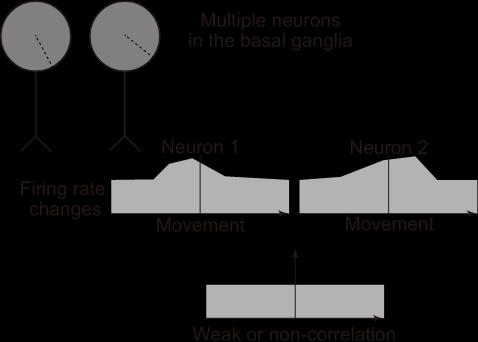firing rate changes or correlated activity?

Credit: Atsushi Nambu
Okazaki, Japan – It is common that neurons transmit information to another group of neurons by increasing or decreasing their activity, i.e. “firing rate changes”. In addition to firing rate changes, synchronized activity of a certain group of neurons, i.e. “correlated activity”, has been suggested to play an important role in conveying information. This study revealed that, in the basal ganglia, information for the movement control is conveyed primarily by firing rate changes and correlated activity play only minor role in healthy conditions (Figure).
The research team consists of Dr. Woranan Wongmassang, Professor Atsushi Nambu, and their colleagues recorded neuronal activity of multiple neurons simultaneously in the basal ganglia while monkeys performed a motor task that required their arm movements. They found that most neurons located in the arm regions of the basal ganglia showed firing rate changes in relation to arm movements. On the other hand, the percentage of neurons that showed correlated activity during the task was very small.
Professor Nambu claims, “Unlike in healthy conditions, a large proportion of neurons in the basal ganglia show strong synchronized activity in Parkinson’s disease. So, it is possible that symptoms could be improved by decreasing abnormally increased correlated activity in the basal ganglia. The findings provide important clues to develop effective treatment for Parkinson’s disease.”
###
The article, “Weakly correlated activity of pallidal neurons in behaving monkeys” was published in European Journal of Neuroscience at DOI [10.1111/ejn.14903].
Media Contact
Atsushi Nambu
[email protected]
Original Source
https:/
Related Journal Article
http://dx.




